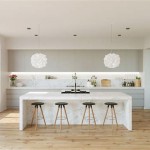Home Decorating Ideas: Painting Walls
Painting walls is a transformative home decorating technique, offering a cost-effective way to refresh a space, inject personality, and enhance the overall aesthetic. Whether undertaking a complete home renovation or simply seeking a subtle change, a fresh coat of paint can make a significant difference. Understanding the nuances of color selection, paint finishes, and application techniques can empower homeowners to achieve professional-looking results while expressing their unique style.
Choosing the Right Color Palette
Color selection is paramount in setting the mood and ambiance of a room. Consider the room's purpose and the desired atmosphere. Cool colors like blues and greens evoke tranquility and serenity, making them ideal for bedrooms and bathrooms. Warm colors such as yellows and oranges promote energy and sociability, making them suitable for living rooms and dining areas. Neutral colors like beige, gray, and white provide a versatile backdrop, allowing for flexibility in incorporating colorful accents through furniture and decor.
Examining the room's lighting is crucial in determining how colors will appear. Natural light can significantly impact color perception, while artificial lighting can either enhance or diminish certain hues. Testing paint samples on the walls in different lighting conditions is highly recommended before committing to a final color. This allows for accurate assessment and ensures the chosen color harmonizes with the room's overall lighting scheme.
Furthermore, consider the existing furniture and decor when selecting a color palette. The wall color should complement the existing elements, creating a cohesive and visually appealing space. Utilizing a color wheel can assist in identifying complementary or contrasting colors that will enhance the overall design scheme. Creating a mood board with paint swatches, fabric samples, and images of furniture can also aid in visualizing the final result.
Exploring Various Paint Finishes
Beyond color selection, the choice of paint finish plays a crucial role in the final appearance and durability of the painted surface. Different finishes offer varying levels of sheen, impacting how light reflects off the walls and how imperfections are masked. Understanding the characteristics of each finish helps in selecting the most appropriate option for a given space.
Matte finishes offer minimal sheen and are excellent for concealing imperfections on wall surfaces. They provide a soft, velvety appearance and are well-suited for low-traffic areas like bedrooms or formal dining rooms. Eggshell finishes offer a subtle sheen, providing a balance between the flatness of matte and the reflectivity of satin. They are more durable than matte finishes and are suitable for living rooms and hallways.
Satin finishes offer a higher sheen and are more durable and easier to clean than matte or eggshell finishes. They are ideal for high-traffic areas such as kitchens, bathrooms, and children's rooms. Semi-gloss and gloss finishes offer the highest sheen and are highly durable and washable. They are often used for trim, doors, and cabinets, but can also be used on walls to create a dramatic and reflective surface.
Proper Application Techniques
Achieving a professional-looking paint job requires proper preparation and application techniques. Preparing the walls by cleaning, patching holes, and sanding uneven surfaces ensures a smooth and even finish. Using quality brushes, rollers, and painter's tape contributes to a clean and precise application, minimizing streaks and drips.
Applying primer before painting is particularly important when painting over dark colors or drastically changing the wall color. Primer provides a uniform base for the paint to adhere to, ensuring consistent color saturation and coverage. It also helps to seal the surface, preventing the underlying color from bleeding through.
Employing the correct painting technique, including using long, even strokes and overlapping each stroke slightly, minimizes streaks and ensures even coverage. Working in smaller sections and maintaining a wet edge helps prevent lap marks and ensures a seamless finish. Allowing sufficient drying time between coats is crucial for achieving optimal results and preventing peeling or cracking.
Utilizing these techniques, individuals can transform their living spaces through the strategic use of color and paint finishes. Careful consideration of color palettes, understanding the properties of different paint finishes, and employing proper application techniques ensures a successful and satisfying outcome. Experimenting with various color combinations and finishes allows individuals to express their unique style and create a personalized living environment that reflects their individual tastes and preferences.

40 Elegant Wall Painting Ideas For Your Beloved Home Bored Art Bedroom Paint Design Tree Decal Living Room

58 Best Wall Art Ideas For Every Room Cool Decor And Prints

20 Artistic Wall Painting Ideas For Your Home Interior Design Matchness Com Creative Paint Designs Decor Living Room

15 Living Room Wall Painting Ideas 2025 Paint Colors For

50 Popular Living Room Colors Paint Ideas

Best Room Paint Apps Wall

78 Beautiful Living Room Ideas For A Timeless Look

58 Best Wall Art Ideas For Every Room Cool Decor And Prints

70 Best Wall Decor Ideas How To Decorate A Blank

Super Cute Diy Wall Paint Idea Painting Home Decor
Related Posts







